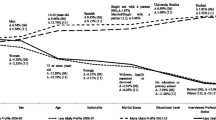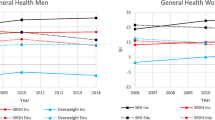Abstract
Objectives
Indicators of socio-economic position are not always available for all subjects. To avoid losses of large parts of study populations, missing data are replaced by spouses’ information. Despite this commonly practiced solution, systematic analyses of the consequences on substantive results of studies are rare. We examined the consequences of assigning the educational position of subjects to their partners.
Methods
German statutory health insurance data from 2005 (N = 1,801,744) and 2011 (N = 1,987,707) were used. Diagnoses of type 2 diabetes were used as outcome. Effects were examined in terms of differences in diabetes prevalence and by the reproduction of social gradients in women and men as compared to their partners.
Results
Social gradients were reproduced for subjects and for their partners, but diabetes prevalences were higher in partners.
Conclusions
From a pragmatic point of view the practice of replacing missing information by spouses’ information turned out as viable. However, the usefulness of this solution has to be examined in every case anew, because it may not be suitable for every health-related outcome.
Similar content being viewed by others
References
Arber S, Ginn J (1993) Gender and inequalities in health in later life. Soc Sci Med 37:33–46
Baxter J (1994) Is husband’s class enough? Class location and class identity. Am Soc Rev 59:220–235
Blackwell DL (1998) Marital homogamy in the United States: the influence of individual and paternal education. Soc Sci Res 27(2):159–188
Bosma H, Appels A, Sturmans F, Grabauskas V, Gostautas A (1995) Educational level of spouses and risk of mortality: the WHO Kaunas–Rotterdam Intervention Study (KRIS). Int J Epidemiol 24(1):119–126
Braveman PA, Cubbin C, Egerter S, Chideya S, Marchi KS, Metzler M, Posner S (2005) Socioeconomic status in health research: one size does not fit all. JAMA 205:2879–2888
Braveman P, Egerter S, Williams DR (2011) The social determinants of health: coming of age. Annu Rev Publ Health 32(1):381–398
Dasgupta K, Khan S, Ross NA (2010) Type 2 diabetes in Canada: concentration of risk among most disadvantaged men but inverse social gradient across groups in women. Diabet Med 27:522–531
Deutsche Diabetes-Hilfe (2012) Deutscher gesundheitsbericht diabetes 2013. Kirchheim, Mainz
Di Castelnuovo A, Quacquaruccio G, Cappuccio FP, Lorgeril M, Dirckx C, Donati MB et al (2007) Cardiovascular risk factors and global risk of fatal cardiovascular disease are positively correlated between partners of 802 married couples from different European countries—report from the IMMIDIET project. Thromb Haemost 98(9):648–655
Di Castelnuovo A, Quacquaruccio G, Donati MB, de Gaetano G, Iacoviello L (2009) Spousal concordance for major coronary risk factors: a systematic review and meta-analysis. Am J Epidemiol 169(1):1–8
Geyer S, Peter R, Nielsen I (2004) Health inequalities in different age groups: the case of type 2-diabetes: a study with health insurance and medication data. Soz Präventiv Med 49:328–335
Geyer S, Hemström Ö, Peter R, Vågerö D (2006) Education, income and occupational class cannot be used interchangeably in social epidemiology. Empirical evidence against an unquestioned practice. J Epidemiol Commun Health 60:804–810
Gliksman MD, Kawachi I, Hunter D, Colditz GA, Manson JE, Stampfer MJ, Speizer FE, Willett WC, Hennekens CH (1995) Childhood socioeconomic status and risk of cardiovascular disease in middle aged US women: a prospective study. J Epidemiol Commun H 49(1):10–15
Goldthorpe J (1983) Women and class analysis: in defence of the conventional view. Sociology 17:465–488
Heidemann C, Du Y, Schubert I, Rathmann W, Scheidt-nave C (2013) Prevalence and temporal trend of known diabetes mellitus: results of the German health interview and examination survey for adults (DEGS1). Bundesgesundheitsbl 56:668–677
Hippisley-Cox J, Pringle M (1998) Are spouses of patients with hypertension at increased risk of having hypertension? A population-based case-control study. Brit J Gen Pract 46:1580–1584
Hoffmann W, Terschüren C, Holle R, Kamtsiuris P, Bergmann M, Kroke S, Sauer S, Stang A, Latza U (2004) Zum problem der response in epidemiologischen studien in Deutschland (Teil II). Gesundheitswesen 66:482–491
Icks A, Rathmann W, Rosenbauer J, Giani G (2005) Diabetes mellitus. Robert-Koch-Institut, Berlin
Jaunzeme J, Eberhard S, Geyer S (2013) Wie „repräsentativ” sind GKV-Daten? Demografische und soziale Unterschiede und Ähnlichkeiten zwischen einer GKV-Versichertenpopulation, der Bevölkerung Niedersachsens sowie der Bundesrepublik am Beispiel der AOK Niedersachsen. Bundesgesundheitsbl 56:447–454
Kalmjin M (1998) Intermarriage and homogamy: causes, Patterns, Trends. Annu Rev Sociol 24:395–421
Lahelma E, Laaksonen M, Martikainen PT, Rahkonen O, Sarlio-Lähteenkorva S (2008) Multiple measures of socioeconomic circumstances and common mental disorders. Soc Sci Med 63:1383–1399
Lee DS, Kim YJ, Han HR (2013) Sex differences in the association between socio-economic status and type 2 diabetes: data from the 2005 Korean National Health and Nutritional Examination Survey (KNHANES). Public Health 127(6):554–560
Leong A, Rahme E, Dasgupta K (2014) Spousal diabetes as a diabetes risk factor: a systematic review and meta-analysis. BMC Med 12(1):12
Lidfeldt J, Li TY, Hu FB, Manson JE, Kawachi I (2007) A prospective study of Childhood and adult socioeconomic status and incidence of type 2 diabetes in women. Am J Epidemiol 165(8):882–889
Minor T (2013) An investigation into the effect of type I and type II diabetes duration on employment and wages. Econ Hum Biol 11(4):534–544
Monden CWS, van Lenthe F, De Graaf ND, Kraaykamp G (2003) Partner’s and own education: does who you live with matter for self-assessed health, smoking and excessive alcohol consumption? Soc Sci Med 57(10):1901–1912
Müller G, Hartwig S, Greiser KH, Moebus S, Pundt N, Schipf S et al (2013) Gender differences in the association of individual social class and neighbourhood unemployment rate with prevalent type 2 diabetes mellitus: a cross-sectional study from the DIAB-CORE consortium. BMJ Open 3(6):e002601. doi:10.1136/bmjopen-2013-002601
Narasimhan S, Weinstock RS (2014) Youth-onset type 2 diabetes mellitus: lessons learned from the TODAY study. Mayo Clin Proc 89(6):806–816
Ni LF, Dai YT, Su TC, Hu WY (2013) Substance use, gender, socioeconomic status and metabolic syndrome among adults in Taiwan. Public Health Nurs 30(1):18–28
Richiardi L, Boffetta P, Merletti F (2002) Analysis of nonresponse bias in a population-based case-control study in lung cancer. J Clin Epidemiol 55(10):1033–1040
Schwartz C, Mare R (2005) Trends in educational assortative marriage from 1940 to 2003. Demography 42(4):621–646
Sorensen A (1994) Women, family, and class. Annu Rev Sociol 20:27–47
StataCorp (2009) Stata statistical software: release 11. StataCorp LP, College Station
Strogatz DS, Siscovick DS, Weiss NS, Rennert G (1988) Wife’s level of education and husband’s risk of primary cardiac arrest. Am J Public Health 78(11):1491–1493
Tunceli K, Bradley CJ, Nerenz D, Williams LK, Pladevall M, Elston Lafata J (2005) The impact of diabetes on employment and work productivity. Diabetes Care 28(11):2662–2667
Vagerö D, Lahelma E (1998) Women, work, and mortality: an analysis of female labor participation. In: Orth-Gomer K, Chesney M, Wenger NK (eds) Women, stress, and heart disease. Lawrence Erlbaum, Mahwa, pp 73–86
Whiting DR, Guariguata L, Weil C, Shaw J (2011) IDF diabetes atlas: global estimates of the prevalence of diabetes for 2011 and 2030. Diabetes Res Clin Pr 94:311–321
Zipp JF, Plutzer E (1996) Wives and husbands: social class, gender, and class identification in the US. Sociology 30(2):235–252
Acknowledgments
The permission of the Allgemeine Ortskrankenkasse Niedersachsen (AOK NDS—Statutory Health Insurance of Lower Saxony) to work with the health insurance data is greatly acknowledged. In particular the support of Jürgen Peter and Sveja Eberhard (AOK NDS) made it possible to carry out the project the data were derived from.
Author information
Authors and Affiliations
Corresponding author
Ethics declarations
Conflict of interest
None.
Funding
The work done by DM was funded by the Ministry of Science and Culture of Lower Saxony as part of the doctoral program GESA: health-related care for a self-determined life in old age—theoretical concepts, users’ needs and responsiveness of the health care system. The work done by JJ was funded by the AOK NDS—Statutory Health Insurance of Lower Saxony as part of a project on morbidity compression.
Rights and permissions
About this article
Cite this article
Muschik, D., Jaunzeme, J. & Geyer, S. Are spouses’ socio-economic classifications interchangeable? Examining the consequences of a commonly used practice in studies on social inequalities in health. Int J Public Health 60, 953–960 (2015). https://doi.org/10.1007/s00038-015-0744-1
Received:
Revised:
Accepted:
Published:
Issue Date:
DOI: https://doi.org/10.1007/s00038-015-0744-1




